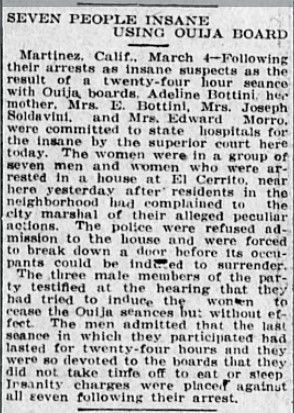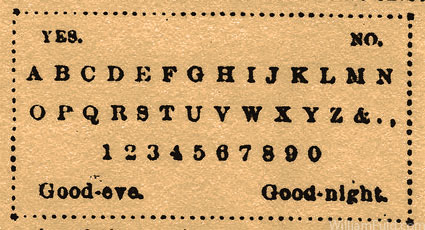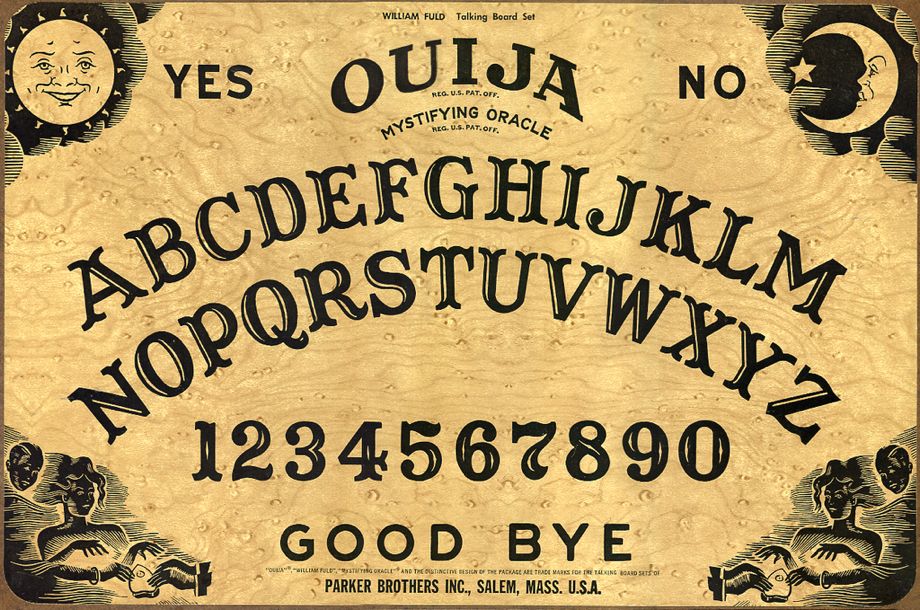
In 1973, The Exorcist terrified moviegoers with its depiction of the demonic possession of Regan MacNeil, a 12-year-old girl whose use of an Ouija board allows the demon, Pazuzu (aka Captain Howdy), to take control of her body. Although this film caused some parents to panic and throw away their kids’ Ouija boards, The Exorcist was far from the first time the Ouija board was blamed for the misdeeds of its users.
The Ouija board game was invented in the United States in 1890 by Elijah Bond, Charles Kennard and William H.A. Maupin, when they recognized a steady increase in the popularity of Spiritualism, or the practice of communicating with the dead. Before the invention of the Ouija board, Spiritualists sought out mediums to help them talk with lost loved ones and other spirits.
Eventually, Spiritualists wanted to communicate with the dead all on their own, from the privacy of their own homes, so they started creating homemade talking boards, which led to the invention of the Ouija board.

Ouija means “good luck” according to Ouija historian, Robert Murch.
The Ouija board works when users place their hands on a triangular shaped planchette that sits on the board and then they ask the spirit(s) they want to communicate with a question. Next, the ideomotor effect takes over. The player(s) unconsciously move the planchette toward the areas on the board that answer the question they posed in the way they subconsciously desire.

So can the Ouija board really cause people to go insane, as posited in the article from 100 years ago today?
In a 2015 article for Psychology Today, Robert Bartholomew Ph.D recommended, “that those with a history of anxiety disorders, dissociative or trance states, and who have an absolute certainty in the existence of the supernatural would be better off steering clear of Ouija-type games.”
If we look back at today’s historical article, it seems that Mrs. Bottini and her 15-year-old daughter, Adeline, as well as Mrs. Saldavini and Mrs. Moro could have been susceptible to a heightened mental agitation from playing the Ouija board. But did they go insane, or were they simply making bad decisions because of severe anxiety and lack of sleep? They did, after all, stay up for multiple 24 hour Ouija sessions in a week long Spiritualist binge.

Saturday Evening Post
In a longer article that ran in the Madera Mercury on Mar 4, 1920, the arresting police officers who broke down the door of the journalist-dubbed ‘House of Mystery’ found “five children, the youngest of whom [was] 2 years old…The hair on the children had been shaved to the scalp and burned ‘to drive evil spirits away.’” The children were — according to neighbors — lured to the house, and were described as being found in a “starving condition”.
Police also found a total of four Ouija boards in the house and evidence that $700 in cash had been burned in the house in an attempt to rid evil spirits.
Here’s a peculiar tie-in to The Exorcist: a local priest, Father J. J. Hennessey, was called in to talk to the Ouija board players and persuade them to open the door to the police, but they refused. No demons, or people for that matter, attacked the priest.
According to Robert Damon Schneck, author of Mrs. Wakeman vs. the Antichrist, when the police first entered and attempted to arrest the so-called ‘Ouijamaniacs‘, Mrs. Moro yelled to them that her husband would kill them if they broke in. However, her husband had died three months earlier. Not only that, but her daughter, Jennie, had been hit and killed by a car just two weeks ago.
So why were only the women in the house deemed insane and locked up? What about the other three men that were also arrested?
All three of the men were released when they “disavowed their belief in the alleged messages of the board and said they took part in the séances in an effort to dissipate the hallucinations of the women.”
The women were let go from their respective asylums after two months, at the end of April, 1920.
